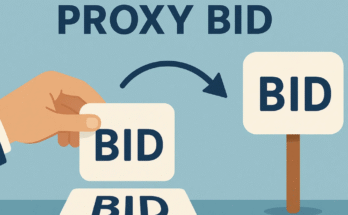Proxy Bidding
If you’ve ever participated in an online auction, chances are you’ve come across the term what is a proxy bid but what does it actually mean?
In simple terms, a proxy bid is an automated bidding system that allows you to set your maximum bid amount, and the system bids incrementally on your behalf until that maximum is reached. This smart, stress-free approach helps you stay competitive without constantly monitoring the auction.
Whether you’re bidding on collectibles on eBay, real estate, or government surplus, understanding how proxy bidding works is a game-changer.
How Does Proxy Bidding Work?
The concept of proxy bidding is rooted in convenience and strategic automation. Instead of manually placing a new bid every time someone outbids you, the proxy system handles that task automatically.
Here’s how it works:
-
You place a maximum bid amount (the highest you’re willing to pay).
-
The system places incremental bids on your behalf.
-
If another bidder places a lower bid than your maximum, the system automatically raises your bid to beat theirs by the minimum increment.
-
You only pay just enough to stay ahead, not necessarily your maximum.
This process continues until either:
-
You win the auction at a price below or equal to your max.
-
Another bidder places a higher max and wins.
Step-by-Step Proxy Bidding Example
Let’s say you’re bidding on a vintage watch. The current price is $50. You enter a proxy bid of $100.
-
Bidder A places a manual bid of $55.
-
The system raises your bid automatically to $56.
-
Bidder A goes to $65 — the system auto-bids you to $66.
-
This continues until your maximum ($100) is reached or no one outbids you.
If no one bids over $100, you win — maybe even at $76, saving you money and effort.
Key Terms You Should Know
| Term | Definition |
|---|---|
| Proxy Bid | An automated bidding system that bids for you up to a preset maximum. |
| Bid Increment | The smallest amount by which the current bid can be raised. |
| Reserve Price | The minimum price a seller is willing to accept. |
| Sniping | Last-second bidding meant to outbid others just before the auction ends. |
| Winning Bid | The highest bid at the close of the auction. |
The Psychology Behind Proxy Bidding
Believe it or not, proxy bidding isn’t just a tool — it’s a psychological buffer.
Here’s why it works:
-
Avoids emotional bidding: You set your limit upfront.
-
Reduces impulsive overspending: No last-minute pressure.
-
Brings peace of mind: You don’t need to babysit the auction.
It levels the playing field, especially for busy bidders who don’t have time to sit and refresh the page every few seconds.
Why Use a Proxy Bid?
Convenience & Automation
With proxy bidding, you’re essentially outsourcing the repetitive part of the auction. This lets you focus on what matters — your budget and strategy, not constant clicking.
Staying Competitive Without Overpaying
Rather than panic-bidding at the last minute, a proxy bid gives you steady control. You win if it’s within your budget. If not, you walk away knowing you stayed disciplined.
Where is Proxy Bidding Most Common?
eBay Proxy Bidding
eBay popularized proxy bidding and still uses it as its core auction model. When you place a bid on eBay, you’re automatically using a proxy bid — even if you don’t realize it.
Government & Real Estate Auctions
Websites like GovDeals, GSA Auctions, and even real estate auction portals use proxy bidding to manage high-value or high-volume auction environments. You set your limit, and the system handles the rest.
Top 10 Secrets to Mastering Proxy Bids
1. Set a Maximum Budget Strategically
Before bidding, research the market value. Set a cap that’s realistic but firm — and never go above it emotionally.
2. Research Past Winning Bids
Study final auction prices for similar items. Sites like eBay let you see sold listings, which is incredibly valuable.
3. Understand Auction Timelines
Know when the auction starts and ends. Bidding earlier with a proxy bid sets you up for a longer competitive edge.
4. Use Auto-Bidding Tools Wisely
Use legitimate auto-bidding or proxy tools provided by the platform — don’t risk your account with third-party bots.
5. Avoid Emotional Bidding
Emotions are your biggest enemy. Let the proxy system do the work — and stick to your original plan.
6. Practice with Low-Stakes Auctions
Start small. Use proxy bids on low-cost items to get a feel for how it works.
7. Choose the Right Platforms
Some sites offer better proxy bidding systems. eBay, HiBid, and GovDeals are top options.
8. Set Alerts & Reminders
Even with proxy bids, set notifications to monitor key moments, like auction endings.
9. Monitor Proxy Bidding Activity
If your proxy bid keeps being outbid quickly, it’s a sign you need to re-evaluate your max or change strategy.
10. Know When to Walk Away
Sometimes losing is winning. If a bidding war takes an item above your max, be proud you didn’t overpay.
Risks and Misconceptions About Proxy Bidding
-
Myth: Proxy bids always win.
Reality: You can still be outbid if someone places a higher maximum. -
Myth: Proxy bidding is unfair.
Reality: It’s an open, transparent system that favors preparation over emotion. -
Myth: You’ll always pay your max.
Nope! You often pay just enough to beat the next bidder, not your full limit.
Legal Aspects of Proxy Bidding
Proxy bidding is completely legal across all major auction sites, as long as it’s done via approved systems. However, beware of shill bidding (fake bids to inflate price), which is illegal and unethical.
Always read a site’s auction policy before participating.
Expert Tips for Safe and Smart Proxy Bidding
-
Stick to reputable platforms.
-
Avoid third-party “sniper” tools that violate terms.
-
Use private browsing when researching similar bids to avoid pricing manipulation.
-
Double-check bid increments — some platforms have odd jumps.
Proxy Bidding vs Sniping: What’s the Difference?

| Feature | Proxy Bidding | Sniping |
|---|---|---|
| Timing | Early or anytime | Last few seconds |
| Automation | Yes | Sometimes, via sniping tools |
| Strategy | Long-term control | Shock value, last-minute win |
| Risk of Overpaying | Lower | Higher |
Verdict: Proxy bidding is safer and more strategic, while sniping is riskier and more aggressive.
External Resources for Online Auction Bidders
-
eBay Help: Bidding – Official guide to eBay’s bidding system.
-
GovDeals.com – Trusted for public surplus auctions.
-
GSA Auctions – US government auction platform for real estate and assets.
FAQs
1. Can I cancel a proxy bid after placing it?
Usually no, but it depends on the platform. eBay, for example, doesn’t allow bid retractions unless there’s a valid reason.
2. Will other bidders see my maximum bid?
No. Only the current highest bid is shown — your max remains hidden unless it’s reached.
3. What happens if two users place the same max bid?
The bidder who entered it first gets the lead.
4. Is proxy bidding better than manual bidding?
Yes, in most cases, it’s faster, smarter, and removes emotional decision-making.
5. Can proxy bidding work on live auctions?
Not always. Proxy bidding is more common on online timed auctions, not real-time ones.
6. Do sellers know I’m using a proxy bid?
No, sellers and other bidders don’t see that you’re using a proxy unless the site makes it public (rarely happens).
Conclusion
Proxy bidding isn’t just a technical feature — it’s a powerful strategy that gives you an edge in online auctions. With the right approach, you can win more items, save money, and avoid the stress of manual bidding wars.



